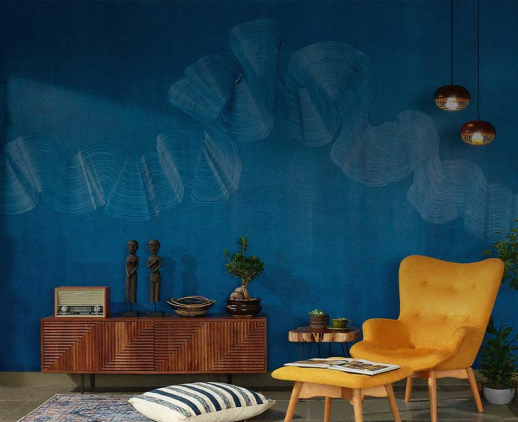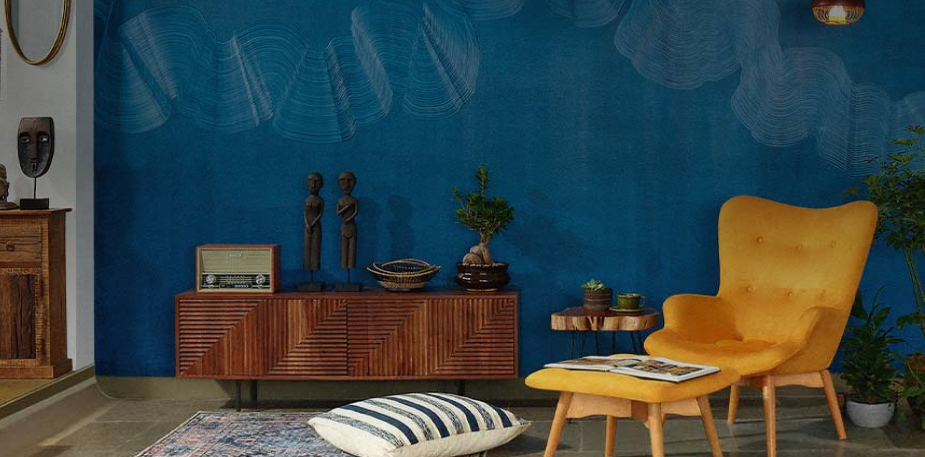Get your home interior design budget estimate
Artist Chandan Dubey’s Mumbai studio is a delight

Restoration artist Chandan Dubey is among the lucky few who enjoyed uninterrupted access to their workspaces since the pandemic began. Just a hop, skip and a jump away from her sea-facing home in Worli, Mumbai, she says her office has kept her sane since lockdown in March. It’s also been an escape for her family, functioning as a makeshift living room with cosy nooks and plenty of sunlight. The space is brimming with the photographer-turned-serial upcycler’s finished projects, WIP art, and a hoard of objects salvaged from flea markets, antique bazaars and well, even off the street. There isn’t an empty spot in sight yet her teenage daughters are comfortable finishing their homework inside the workshop on foldable tables.
Chandan’s circular approach to design means there is clutter everywhere but the space is never messy. Her day begins and ends with a tidying and cleaning ritual that she swears by so she can revel in free play as she fashions wall art from old temple prabhavalis, cushion covers and homewares from endless amounts of fabric scraps and hand painted art deco furniture. She takes us through her space, a typical working day and where she stores all of her scavenged treasures:
BH: How did you end up as a restoration artist?
CD: I started my career as a business journalist. During my stint at Asian Age, I spent a lot of time with the photo team and even processed my first prints in the dark room there. This led me to fine art photography and even as we speak, I’m studying the light pouring in and rules of composition continue to guide my practice.
I enrolled in the Hong Kong Art School to pursue Art History and Curating. This gave me a ringside view of artists at work, a chance to see them in their authentic environments working expressing themselves through so many different mediums.
I am a busy body and I find that working with my hands calms me. As a craftsperson, I enjoy playing with different materials, trying new things and learning new skills. I enjoy the exploratory nature of my work. An educated conservationist would be horrified at how I breathe new life into found objects so they are attractive to the end user.

Chandan Dubey at her Worli studio.

The cow is a running motif in Chandan’s work. She likens her persona at work to the Indian bovine that thrives in chaos – calm and unfrazzled in the face of constant change. Inspired by the murals of the animal in her hometown Varnasi and Udaipur, she worked with a local student artist to create three life-size figures across a corridor wall.

An antique study table is Chandan’s physical “ZenDesk”. It’s where the artist sits down to doodle, scribble and sketch and sometimes the more mundane task of book-keeping. A vintage phrenology chart of the brain from Nappa Dori is part of her collection of anatomical art.
BH: Please show us around your studio.
CD: My studio is just two rooms connected by a narrow corridor. You walk into the main room where I display whatever I have available on a gallery wall with very narrow wooden shelves that are expandable to save space. A lot of my work is commissioned and seasonal so this room is always changing. I have a small computer desk here and a concrete bench so most of my work happens in the room at the back. This room is for family, for conversation and for meeting my friends and clients. In the other room, we broke down a wall and added windows to what felt like a dungeon before we changed it around. There is a hardy concrete top in the pantry for all the wet work and a large desk with a cutting board for larger projects. All the storage and furniture is repurposed, there is nothing new in my studio design.
BH: Where do you store all your tools and scavenging finds?
CD: Everywhere. In the main room, I found a paowala’s storage box that was left on the street when a bakery was shutting down in Mohammed Ali Road. I use it to store my textiles. I store my iron and other sewing supplies in an old church shrine box. From Chor Bazaar, I bought corner cabinets and a huge ‘60s filing cabinet that has little numbered pull-outs that add a nice typographical element to the room. There’s also a big blue cupboard made with shutters I found at Chor Bazaar.
BH: What is a typical work day like here at your studio and what are some tools you simply can’t do without?
CD: I come in and the first thing I like to do is clean the studio myself. I light a candle with my favourite lemongrass scent, make some coffee and pen a to-do list; all of this is so calming. I spend some time planning orders, making timelines for my commissioned projects. Some days there is a burst of activity and other days can be quite unproductive. I’m always sharpening pencils, like Gandhiji, I never throw out even the smallest stubs. Apart from Fevicol, paints and brushes, you’ll never find me without a measuring tape. I think I will die with a measuring tape in my hand.
BH: Finally, what are you presently working on?
CD: Since the first lockdown, I pivoted my medium to textiles since they were the easiest to source. I bought industry-grade sewing and embroidery machines. I am currently working on a collection of cushion covers, table runners and throws for Diwali. I am also looking forward to enrolling myself in the Southeast Asian Art and Architecture programme at Jnanapravaha—I am an academic at heart.

Get Started with your interior design journey with us!
Speak to our design professionals
What’s the status of your home possession?
What’s the condition of your home/space?
Will you be living in your space during the renovation?
 Previous Question
Previous Question
Is your interior design budget over 4 lakhs?
 Previous Question
Previous Question
Book next available appointment slots with our experts!
Please Select Date and Day
 Previous Question
Previous Question

Something went wrong!
We were unable to receive your details. Please try submitting them again.

Appointment Scheduled!
Thank you for giving an opportunity to Asian Paints Beautiful Homes Service! Our Customer Experience Specialist will get in touch with you soon.
Appointment Date & time
Thank You!
Our team will contact you for further details.
What’s the status of your home possession?
What’s the condition of your home/space?
Will you be living in your space during the renovation ?
 Previous Question
Previous Question
Is your interior design budget over 4 lakhs?
 Previous Question
Previous Question
Book next available appointment slots with our experts!
DEC 2023
Please Select Date and Day
 Previous Question
Previous Question

Something went wrong!
We were unable to receive your details. Please try submitting them again.

Appointment Scheduled!
Thank you for giving an opportunity to Asian Paints Beautiful Homes Service! Our Customer Experience Specialist will get in touch with you soon.
Appointment Date & time
17 Oct 23, 03.00PM - 04.00PM














































